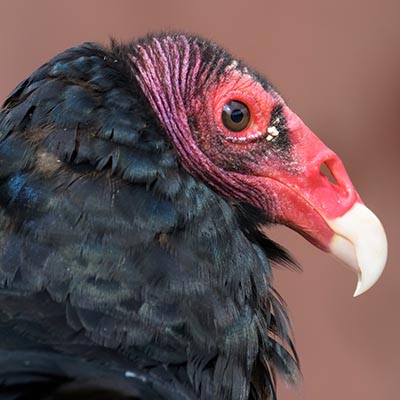 Most people know a turkey vulture when they see one. Turkey vultures may be one of the world's most graceful soaring birds. These large dark birds with featherless red heads are commonly seen circling in the skies above, roosting in large family groups, or perched alongside a roadkilled carcass. They are easy to spot in the air, as they usually hold their wings in a slight "V" as they fly. Their scientific name, Cathartes aura, means "pacifier" or "cleanser". The Cherokee Nation assigned them the honorific title "Peace Eagle" based on their resemblance, from a distance to an eagle and the fact that they do not (and cannot) kill prey. However, most people do not find these odd-looking birds or their habits, endearing. It just depends on how you look at them!!
Most people know a turkey vulture when they see one. Turkey vultures may be one of the world's most graceful soaring birds. These large dark birds with featherless red heads are commonly seen circling in the skies above, roosting in large family groups, or perched alongside a roadkilled carcass. They are easy to spot in the air, as they usually hold their wings in a slight "V" as they fly. Their scientific name, Cathartes aura, means "pacifier" or "cleanser". The Cherokee Nation assigned them the honorific title "Peace Eagle" based on their resemblance, from a distance to an eagle and the fact that they do not (and cannot) kill prey. However, most people do not find these odd-looking birds or their habits, endearing. It just depends on how you look at them!!
Turkey vultures are infamous for eating the remains of dead animals, but they also consume up to 50 percent of their diet in vegetation! The stomach of a turkey vulture is able to kill any virus or bacteria, an intriguing fact to the medical industry.
The featherless head of a turkey vulture is a useful adaptation for its feeding habits. Feathers would become encrusted with the contents of a carcass during foraging, subjecting the bird to insect infestation and bacteria. That bald head allows for easy cleaning!! They bathe frequently, especially after eating.
Turkey vultures seem to have a genuine curiosity about people and objects. Roosts are often near humans. In wildlife rehabilitation centers where injured turkey vultures are treated and in the wild, they have been known to bond with a certain individual and follow them around, watching their activities. One story tells of a turkey vulture that found "its person" in a town of 12,000 people. A turkey vulture in rehab will often bring someone an object and then play "tug-of-war." Caretakers who have worked with them have found them to be "...gentle, inquisitive, and very intelligent". Another story tells of a group of turkey vultures playing together every evening with a ball left out in someone's yard.
Turkey vultures can be found year-round in Indiana today, although most of the individuals in this species shift further south for the winter.
Do you know the difference between a turkey vulture, a bald eagle, and an osprey in flight? If not, check out this page to learn about these three amazing raptors.
